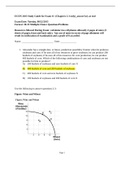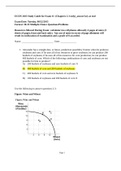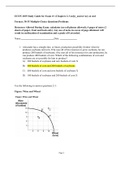ECON 2105 Exam 1 (ECON 2105 Exam 1 Study Guide)
Georgia Institute of Technology
All 3 results
Sort by

-
ECON 2105 Exam 1 Study Guide- Georgia Institute Of Technology
- Other • 33 pages • 2021
- Available in package deal
-
- $13.49
- + learn more
1. Alexander has a straight-line, or linear, production possibility frontier when he produces soybeans and corn. If he uses all of his resources to grow soybeans, he can produce 200 bushels of soybeans; if he uses all of his resources for corn production, he can produce 400 bushels of corn. Which of the following combinations of corn and soybeans are not possible for him to produce? A) 200 bushels of soybeans and zero bushels of corn X B) 600 bushels of corn and 200 bushels of soybeans C) 400 bu...

-
ECON 2105 Exam 1 Study Guide- Georgia Institute Of Technology
- Other • 33 pages • 2021
-
- $15.49
- + learn more
1. Alexander has a straight-line, or linear, production possibility frontier when he produces soybeans and corn. If he uses all of his resources to grow soybeans, he can produce 200 bushels of soybeans; if he uses all of his resources for corn production, he can produce 400 bushels of corn. Which of the following combinations of corn and soybeans are not possible for him to produce? A) 200 bushels of soybeans and zero bushels of corn X B) 600 bushels of corn and 200 bushels of soybeans C) 400 bu...

-
ECON 2105 Exam 1 Study Guide- Georgia Institute Of Technology
- Other • 33 pages • 2021
-
- $15.49
- + learn more
1. Alexander has a straight-line, or linear, production possibility frontier when he produces soybeans and corn. If he uses all of his resources to grow soybeans, he can produce 200 bushels of soybeans; if he uses all of his resources for corn production, he can produce 400 bushels of corn. Which of the following combinations of corn and soybeans are not possible for him to produce? A) 200 bushels of soybeans and zero bushels of corn X B) 600 bushels of corn and 200 bushels of soybeans C) 400...

How much did you already spend on Stuvia? Imagine there are plenty more of you out there paying for study notes, but this time YOU are the seller. Ka-ching! Discover all about earning on Stuvia


